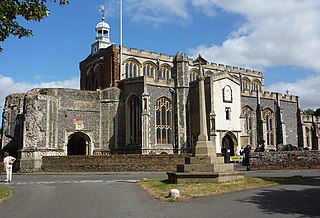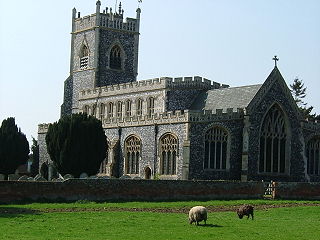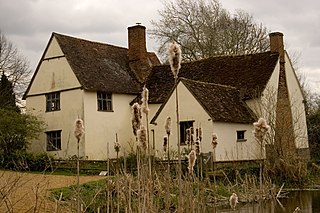
East Bergholt Abbey was an abbey in Suffolk, England. It was built on land purchased in 1857 on the site of Old Hall manor. [1]

East Bergholt Abbey was an abbey in Suffolk, England. It was built on land purchased in 1857 on the site of Old Hall manor. [1]
Old Hall was the principal manor of East Bergholt. It was acquired in 1701 by Joseph Chaplain, wine cooper and High Sheriff of Suffolk, purchased the property in 1701, and built a manor house to replace an earlier Elizabethan structure. The property came into the possession of John Reade, who in 1801, commissioned John Constable to do a painting of the house. [2] In 1806, Peter Godfrey bought the manor, and extended his holdings. Constable continued to visit, finding views to paint.
The community dated back to one founded in Brussels specifically for English women in 1598 by Lady Mary Percy. [3] With the French Revolution, the nuns returned to England in 1794, settling first at Winchester where they opened a school. [4]
In 1856, Benedictine nuns purchased the estate from the Godfreys. Architect George Goldie was retained to adapt the manor house into a monastery. He added a chapel and a chapter house. The nuns farmed the land, and opened a school. In 1876 the school was closed, and the Order became an enclosed, contemplative community. The nuns baked their own bread, made their own wine and beer, kept bees, made butter and cheese, and participated in local agricultural shows. They also supplemented their income by making vestments. In lean times, they provided charitable assistance. [5]
During World War II, the community of nuns was evacuated from the coast, some members went to Stanbrook Abbey, others to Swynnerton. The Abbey was requisitioned by the military. After the War, the building was in such poor condition that the nuns decided to sell the property and relocate to Haslemere. Haslemere closed in 1975 and the nuns dispersed to Stanbrook, Warwick, Oulton Abbey, and St Scholastica's Abbey. The last member of the community died in 1995.
In 1946, Franciscans established a friary on the grounds. [6] The friars at East Bergholt served at Brantham and St Mark, Ipswich. Around 1973 most of the friars moved to Canterbury, while a few set up small friary at Ipswich. The property was sold in 1973.
The property is privately owned as communal housing. [7]

The dissolution of the monasteries, occasionally referred to as the suppression of the monasteries, was the set of administrative and legal processes between 1536 and 1541 by which Henry VIII disbanded monasteries, priories, convents, and friaries in England, Wales, and Ireland, expropriated their income, disposed of their assets, and provided for their former personnel and functions. Although the policy was originally envisaged as increasing the regular income of the Crown, much former monastic property was sold off to fund Henry's military campaigns in the 1540s. He was given the authority to do this in England and Wales by the Act of Supremacy, passed by Parliament in 1534, which made him Supreme Head of the Church in England, thus separating England from papal authority, and by the First Suppression Act (1535) and the Second Suppression Act (1539). While Thomas Cromwell, vicar-general and vicegerent of England, is often considered the leader of the dissolutions, he merely oversaw the project, one he had hoped to use for reform of monasteries, not closure or seizure. The dissolution project was created by England's Lord Chancellor Thomas Audley, and Court of Augmentations head Richard Rich.

East Bergholt is a village in the Babergh District of Suffolk, England, just north of the Essex border.

Stratford St. Mary is a village in Suffolk, England in the heart of 'Constable Country'. John Constable painted a number of paintings in and around Stratford.

Brantham is a village and civil parish in the Babergh district of Suffolk, England. It is located close to the River Stour and the border with Essex, around 2 miles (3 km) north of Manningtree, and around 9 miles (14 km) southwest of Ipswich.

Stanbrook Abbey is a Catholic contemplative Benedictine women's monastery with the status of an abbey, located at Wass, North Yorkshire, England.

Burnham Abbey was a house of Augustinian canonesses regular near Burnham in Buckinghamshire, England. It was founded in 1266 by Richard, 1st Earl of Cornwall. The abbey of St Mary consisted of around twenty nuns at the outset, but was never wealthy and by the time of its dissolution in 1539 there were only ten.

Willy Lott's Cottage is a house in Flatford, East Bergholt, Suffolk, England which appears in several paintings by John Constable, notably The Hay Wain.
Ipswich Whitefriars was the medieval religious house of Carmelite friars which formerly stood near the centre of the town of Ipswich, the county town of Suffolk, UK. It was the last of the three principal friaries to be founded in Ipswich, the first being the Ipswich Greyfriars (Franciscans), under Tibetot family patronage before 1236, and the second the Ipswich Blackfriars (Dominicans) founded by King Henry III in 1263. The house of the Carmelite Order of White Friars was established in c. 1278–79. In its heyday it was the home of many eminent scholars, supplied several Provincial superiors of the Order in England, and was repeatedly host to the provincial chapters of the Order.

Ingress Abbey is a Neo-gothic Jacobean-style country house in Greenhithe, Kent, England, built in 1833 on the site of an earlier Palladian-style house.

Teignmouth Abbey or St. Scholastica's Abbey is a former abbey in Devon, England.

King's Langley Priory was a Dominican priory in Kings Langley, Hertfordshire, England. It was located adjacent to the Kings Langley Royal Palace, residence of the Plantagenet English kings.

St. Mark's Roman Catholic Church is a Catholic church on the Chantry Estate in Ipswich. It is part of the Roman Catholic Diocese of East Anglia. It opened in May 1959.

Ipswich Blackfriars was a medieval religious house of Friars-preachers (Dominicans) in the town of Ipswich, Suffolk, England, founded in 1263 by King Henry III and dissolved in 1538. It was the second of the three friaries established in the town, the first being the Greyfriars, a house of Franciscan Friars Minors, and the third the Ipswich Whitefriars of c. 1278–79. The Blackfriars were under the Visitation of Cambridge.

Ipswich Greyfriars was a mediaeval monastic house of Friars Minor (Franciscans) founded during the 13th century in Ipswich, Suffolk. It was said conventionally to have been founded by Sir Robert Tibetot of Nettlestead, Suffolk, but the foundation is accepted to be set back before 1236. This makes it the earliest house of mendicant friars in Suffolk, and established no more than ten years after the death of St Francis himself. It was within the Cambridge Custody. It remained active until dissolved in the late 1530s.

Hitchin Priory in Hitchin in Hertfordshire is today a hotel built in about 1700 on the site of a Carmelite friary founded in 1317, which was closed in the Dissolution of the Monasteries during the reign of Henry VIII. Parts of the original priory are incorporated in the existing building, which has been a Grade I listed building on the Register of Historic England since 1951.
Coordinates: 51°58′10″N1°00′49″E / 51.969487°N 1.0135438°E